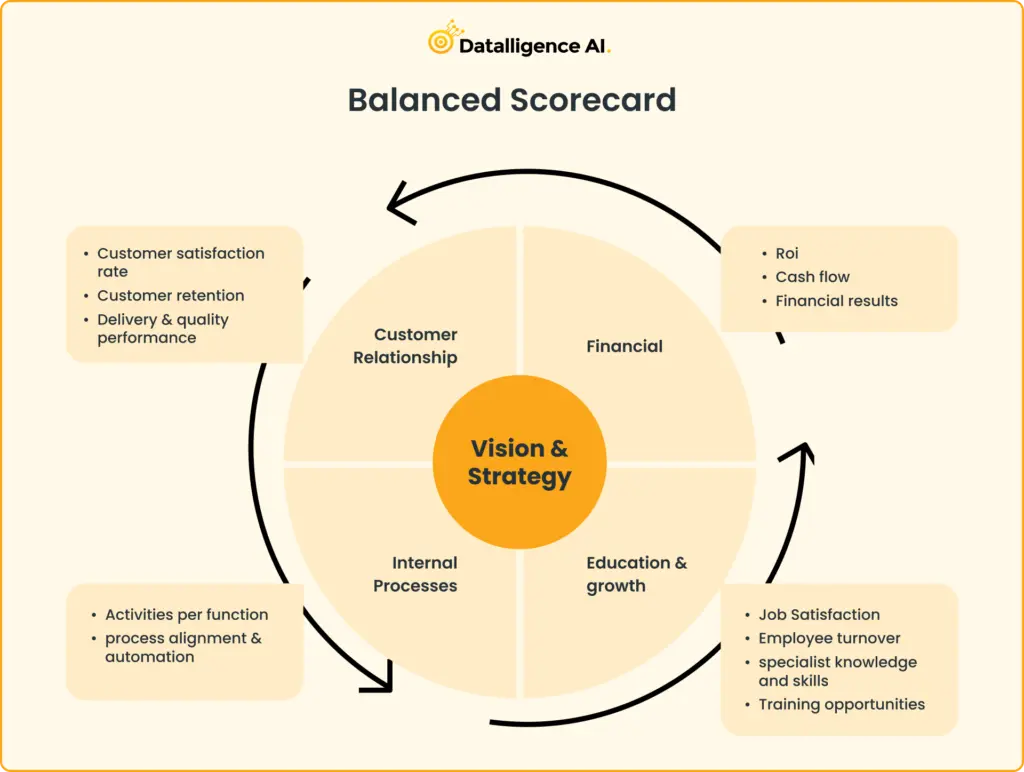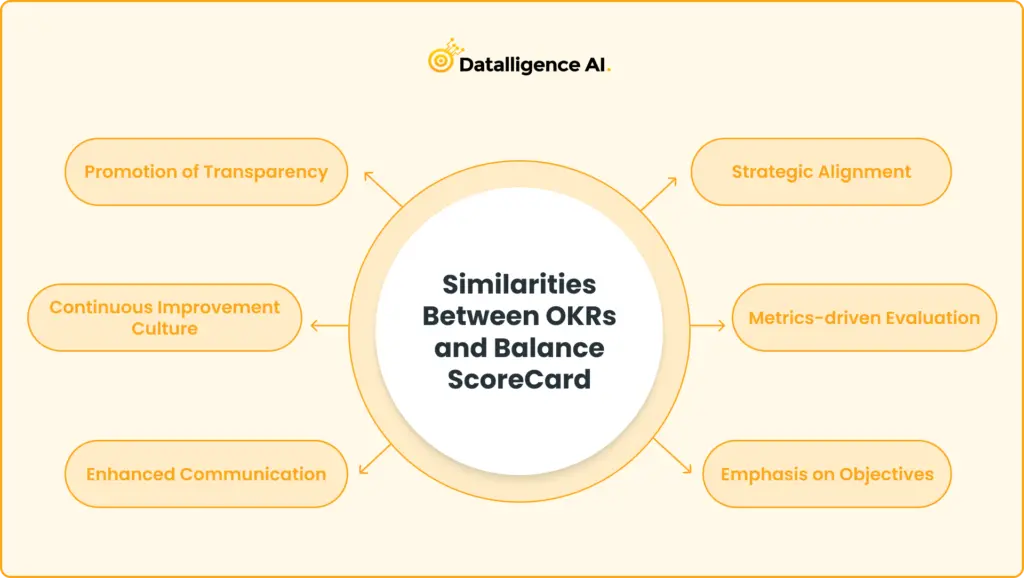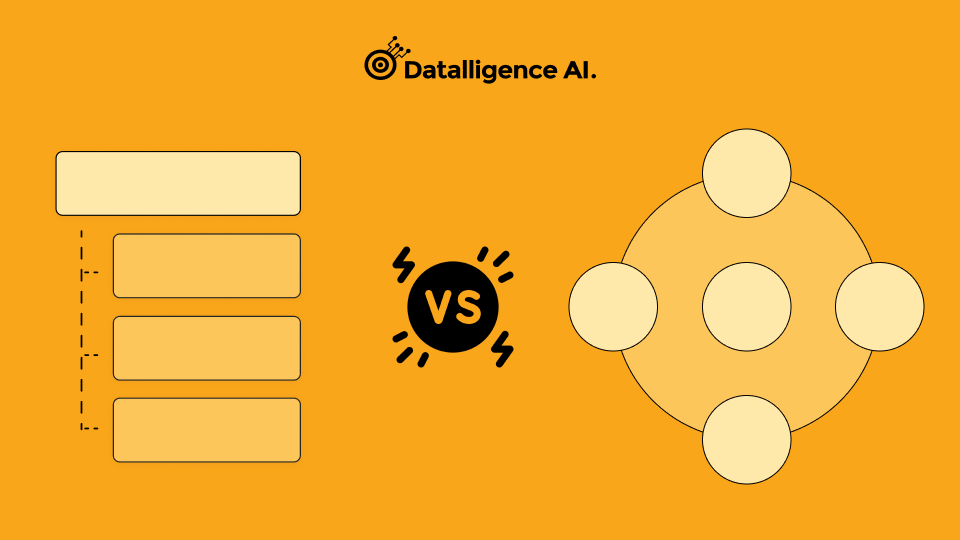Navigating the world of performance metrics can often feel like traversing a labyrinth, with various tools and systems promising to be the ideal solution for your organization's needs. Today, we'll unravel the intricacies surrounding two popular methodologies that many organizations find themselves evaluating: OKR frameworks vs. Balanced Scorecards. You might have stumbled upon terms like "Balanced Scorecard vs. OKR frameworks " or pondered over how an "OKR scorecard" might differ from a "balanced scorecard objective."
We'll shed light on these terminologies and more, providing you with a clearer roadmap to select the right approach for your business.
Table of Contents
What is Balance ScoreCard

The Balanced Score Card (BSC) is a strategic planning and management system that organizations use not only to track their performance against operational objectives but also to ensure that they are aligned with their overall strategy. Developed by Drs. Robert Kaplan and David Norton in the early 1990s, the BSC has since become a foundational tool in strategic performance management across a myriad of industries globally.
Key Components of the Balanced Score Card
BSC breaks down into four distinct perspectives, which collectively provide a holistic view of an organization's performance:
- Financial Perspective: Focuses on metrics such as profitability, revenue growth, and return on investment.
- Customer Perspective: Concentrates on customer satisfaction, retention rates, and market share.
- Internal Process Perspective: Evaluates operational efficiency metrics like process efficiency and quality.
- Learning & Growth Perspective: Assesses an organization's ability to innovate and improve, with metrics related to employee training and corporate culture.
Examples of the Balanced Score Card in Action
Manufacturing Company
- Financial: Increase quarterly profits by 10%.
- Customer: Achieve a 95% customer satisfaction rate.
- Internal Processes: Reduce production cycle times by 15%.
- Learning & Growth: Train 90% of employees in new production technology.
Healthcare Institution
- Financial: Reduce operational costs by 5%.
- Customer: Attain a patient satisfaction rate of 98%.
- Internal Processes: Implement electronic medical records in all departments.
- Learning & Growth: Launch a continuous medical education program for all staff.
In essence, the Balanced Score Card offers organizations a balanced way to look at their operations from the most critical perspectives. It ensures that businesses are not just driven by financial metrics but also value their customers, internal processes, and capacity for growth and learning.
What are OKR frameworks?
OKR stands for "Objectives and Key Results." It's a powerful goal-setting framework widely adopted by companies to define and track objectives along with the measurable results needed to achieve them. The "Objective" outlines a clear goal, while "Key Results" specify the measurable steps or outcomes needed to reach that goal. Popularized by tech companies like Google, OKRs promote alignment, clarity, and focus in organizations, ensuring teams work collaboratively towards shared objectives.
OKR Example
Objective: Enhance user engagement on our mobile app.
- Key Result 1: Increase daily active users by 20%.
- Key Result 2: Achieve a session duration of 5 minutes on average.
- Key Result 3: Reduce app churn rate to under 3%.
By setting and tracking OKRs, organizations can ensure focus, alignment, and clarity on what needs to be achieved and how success looks.
Learn more about Writing OKRs and OKR Examples in our latest blog.
OKR and Balance ScoreCard: What's the Difference

Similarities Between OKRs and Balance ScoreCard

Both Balanced Scorecard (BSC) and OKR (Objectives and Key Results) are recognized frameworks employed by organizations to streamline their strategies and ensure efficient performance tracking.
Though they originate from different backgrounds and have distinct approaches, there are some undeniable parallels:
Strategic Alignment
The essence of both methodologies lies in aligning every level of an organization—from top-tier leadership down to the grassroots—with the overarching organizational strategy and objectives.
Metrics-driven Evaluation
BSC and OKR advocate for the measurement of performance using quantifiable metrics or key results. This data-driven approach aids in setting clear benchmarks for success and gauging progress.
Emphasis on Objectives
Whether it's the broader objectives in OKRs or the strategic goals in BSC, both frameworks stress the importance of setting clear, actionable objectives that provide direction and purpose.
Promotion of Transparency
For both OKR and BSC, transparency is key. By making goals, results, and progress transparent, they encourage accountability, collective responsibility, and informed decision-making.
Continuous Improvement Culture
Both systems nurture a continuous improvement mindset. Regular check-ins, reviews, and feedback loops are integral, ensuring that organizations remain adaptive and agile in response to challenges and insights.
Enhanced Communication
Both BSC and OKR serve as conduits for clear communication of organizational priorities. They ensure that everyone, irrespective of their role or level, understands and works towards common goals.
In essence, while they might diverge in their specifics, BSC and OKR share a unified vision of driving organizational excellence through clarity, alignment, and measurable outcomes.
Can We Combine OKRs and Balance ScoreCard
Merging OKRs with the Balanced Score Card can be a game-changer for organizations. The BSC, with its overarching strategic perspectives, sets the stage. Enter OKRs, which infuse short-term, agile objectives into each BSC domain.
For instance, under BSC's "Customer" perspective, an OKR might be set as
Objective: Enhance Customer Satisfaction.
- KR 1:Reduce response time to customer inquiries by 30% this quarter.
- KR 2:Achieve a 10% increase in positive customer feedback.
Frequent OKR check-ins ensure agility, allowing teams to pivot based on real-time feedback. Meanwhile, periodic BSC reviews ensure alignment with the bigger picture. This blend harnesses both the strategic depth of BSC and the adaptability of OKRs, ensuring a comprehensive approach to achieving both immediate and long-term goals.
Pros and Cons Of Combining OKRs and Balance ScoreCard
Combining OKRs with the Balanced Scorecard presents an opportunity to mesh agile goal-setting with comprehensive strategic planning. While this fusion can supercharge an organization's approach to performance management, it's crucial to weigh the benefits against the potential challenges.
Pros of Combining OKRs and Balance ScoreCard
- Merges BSC's holistic strategy with OKRs' agility.
- Ensures alignment across all organizational levels.
- Provides a balanced focus on different areas of the organization.
- Allows for both long-term vision and adaptability to change.
- Boosts communication and transparency across the board.
Cons of Combining OKRs and Balance ScoreCard
- Can be complex to manage both systems together.
- Might demand more resources in terms of time and effort.
- Possible redundancies between objectives or metrics.
- Each framework's distinct advantages might get overshadowed.
- Staff training can become more challenging.
OKRs vs. Balanced Scorecard- Which one will you choose
The decision largely rests on what your organization values more: agility or comprehensive strategic planning. If you're in a rapidly changing industry, the adaptability of OKRs might be more appealing. On the other hand, if you're looking to implement a broad, long-term strategy, the Balanced Scorecard's holistic approach might resonate better.
However, it's also worth noting that some organizations successfully integrate both. They use the BSC for overarching strategic planning and OKRs for agile execution, combining the strengths of both systems.
Conclusion
Choosing between OKRs and the Balanced Scorecard is not about selecting the 'better' framework but about recognizing which aligns best with your organization's needs, culture, and industry demands.
For those still on the fence, platforms like Datalligence can be invaluable. Datalligence offers robust tools that cater to both OKRs and Balanced Scorecard methodologies. By leveraging their expertise, you can seamlessly integrate and manage your chosen framework, ensuring optimal alignment, transparency, and performance tracking.So, whether you lean towards OKRs, the Balanced Scorecard, or a fusion of both, tools like Datalligence can be your guide in this journey of strategic performance management. Talk to our Experts and Coaches and gain more insights or try Datalligence for Free.











